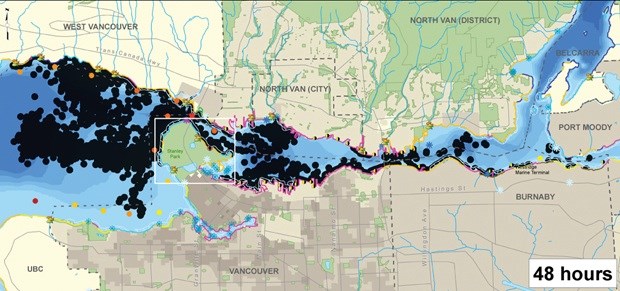In a worst-case scenario, over half of the oil from a major oil spill would reach the shores of Burrard Inlet within hours, then be spread within days from the beaches of West Vancouver to the remote reaches of Indian Arm — and everywhere in between.
That’s one of the conclusions reached in an oil-spill modelling study conducted for the Tsleil-Waututh Nation, City of Vancouver and City of Burnaby to examine possible impacts in the event of an oil spill from a tanker coming from Kinder Morgan’s Westridge Terminal in Burnaby.
One of the striking conclusions of the study — which assumes no clean-up efforts are in place — is “how quickly the oil moves to the shoreline and lands there,” said John Konovsky, a natural resources planner and technical advisor to the Tsleil-Waututh on the oil pipeline issue.
“Even Indian Arm under certain circumstances is at risk of oiling,” he said, which is especially concerning to the Tsleil-Waututh. “We depend on that clean water for many of our traditional activities.”
The study used information about wind and tide patterns in Burrard Inlet to model where oil from a major 16 million-litre spill could end up.
Konovsky said the Tsleil-Waututh commissioned the report because it felt the oil spill modelling by Kinder Morgan was inadequate.
The work by Kinder Morgan “modelled a very small spill at the Westridge marine terminal and didn’t do any other work in Burrard Inlet,” said Konovsky. “We felt there should be some examination of a large spill to determine what effect a large spill would have.”
The modelling done by Kinder Morgan also did not take into account oil getting washed on ashore, then lifted off and circulated to other areas of the inlet, according to Friday’s report, conducted by Genwest Systems.
According to the Genwest report, Kinder Morgan used the “unreasonable assumption that the containment boom is always in place and always works.” But that is “not the historical norm” according to the report’s authors. In contrast, the Genwest report concludes, “a significant fraction of Burrard Inlet is potentially threatened” in the event of a major spill.
Local mayors were presented with the report at a Metro Vancouver meeting Friday morning.
City of North Vancouver Mayor Darrell Mussatto said the report, and its animated video, show dramatically what’s at stake in a worst-case scenario. “There’s a lot of impact to the whole North Shore,” he said.
West Vancouver Mayor Michael Smith said the scenarios presented showed “we’d have a horrific effect on West Vancouver” in the event of a major spill.
But both mayors cautioned the report does not include modeling of any clean-up efforts — which would be unlikely.
Kinder Morgan spokesperson Ali Hounsell said the company stands by its assessments but would analyze the new report.
“We’ll be doing a more detailed review of it. It’s a pretty lengthy report,” she said. The issue of whether a spill response is included in the model is key, she added.
Konovsky acknowledged the report assumed no spill clean up, but said an additional study that addresses that issue is in the works.
“There was a 12-hour delay during the Marathassa (oil spill),” he added. “That’s enough time for a significant amount of oil to hit the shorelines.”
Smith said he shares concerns about response time, describing the response to the Marathassa spill “embarrassingly weak.”
The last two beaches in West Vancouver closed because of oil washed up during the Marathassa spill April 8 reopened on Friday. The ban on crab fishing in the area has also been lifted.



